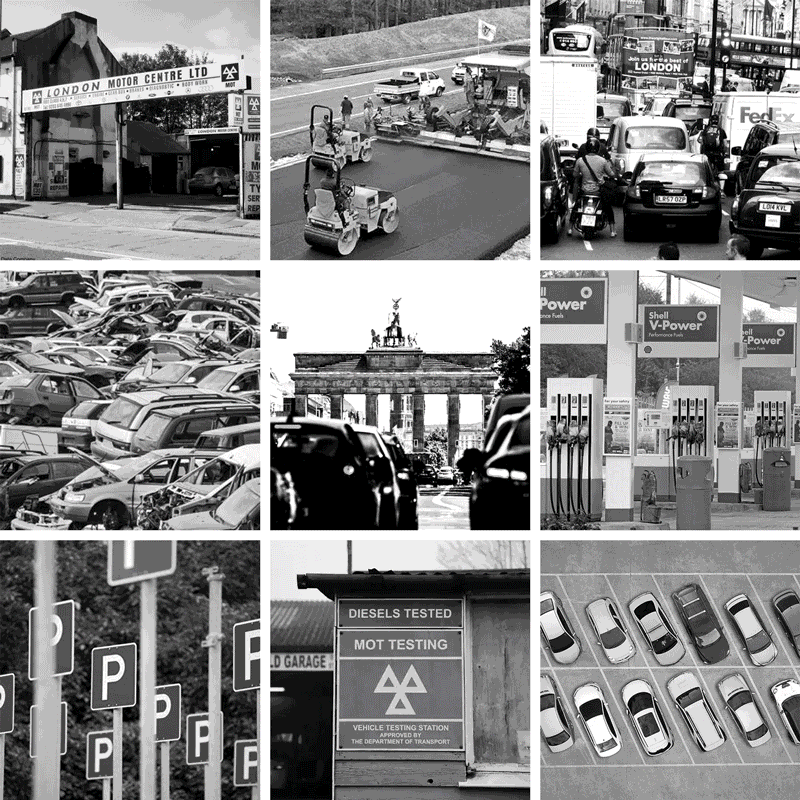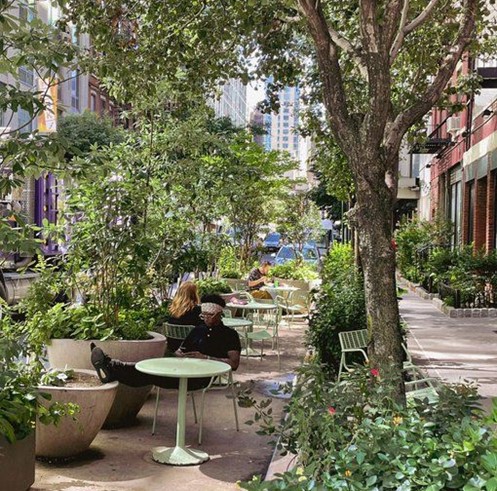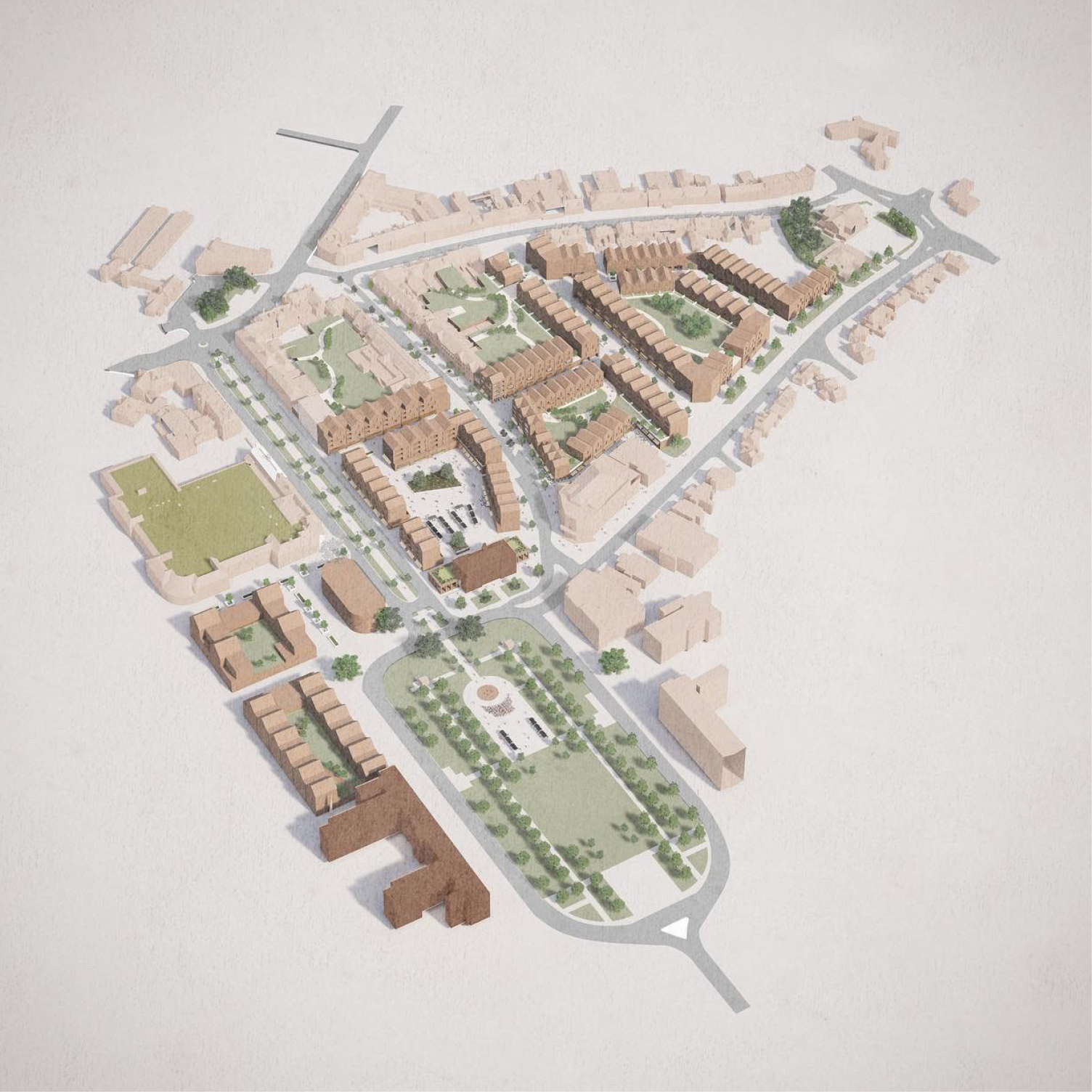
The Opportunities of the Car Free City
Hutchinson & Partners have undertaken research on the opportunities of the car free city and to lend a voice in support of reducing car use to help make our cities more sustainable and contribute to populations across the world having a better quality of life.
Imagine cities free of Petrol Pumps, MOT Centres, Tyre Centres, Car Showrooms, Car Parks, Service Yards, Windscreen Repair Centres…any and all elements of our city infrastructure linked to cars. A city with this much land made available for redevelopment would have a unique opportunity to set a new standard for the future. A city free of cars could open up a whole range of possibilities for the relationship we have with our urban and sub-urban areas.
Since 2018, Hutchinson & Partners offices in London and Berlin have been engaged in research investigating the opportunities of the car free city. Our ongoing Berlin research project, Twelve Sites, has mapped a variety of car dependant infrastructure sites across Berlin. We are now in the process of applying similar research to sites across London
The research undertaken by our Berlin office has identified 850 car related sites across the twelve districts of Berlin. These sites were assessed with regards to future development opportunities in relation to their location, connectivity, and site complexity to give a rating used to establish their potential. Of the 850 sites identified, 353 were deemed rateable with 226 (64%) of the sites deemed to have high development potential. It is our intention that through this analysis and mapping of these sites we can start a conversation about their future position.
The realisation of the impact that the car is having on our individual and collective lives is growing, Cars are increasingly seen as a habit of convenience and an outmoded status symbol. Getting rid of your car is becoming increasingly seen as one of the biggest contributions an individual or a family can make in reducing their emissions. Younger generations are already growing up without the expectation, or want, of car ownership.
A move towards a future city where the focus of the built environment is not centred around the car but given back to the people who live in it, is something that is currently being discussed, tested and to a certain extent implemented in towns and cities around the world.
Earlier this year 50,000 Berliners signed a petition by Berlin Autofrei[1] calling for cars to be banned from 88 square kilometers of central Berlin (within the S-Bahn ring). This would create the largest car-free urban district in the world, equivalent to the area covered by Zones 1 & 2 in London. In Paris, a ban has been announced on most cars driving through the city that will take effect in 2024. We are also seeing London and other major urban centres targeting a reduction in car use through policy changes with the new London Plan stating “car-free development should be the starting point for all development”. Also, other recent changes such as making the congestion charge apply to private-hire vehicles and introducing the ultra-low emission zone have further reduced the amount of cars within central London. This isn’t necessarily the case outside of these areas. We are still seeing 1:1 parking ratio requirements for residential developments being requested by authorities of commuter belt towns, despite being within half an hour train ride of London.
Hopefully the outcome from these discussions, trials and policy changes will result in a move towards refocussing our efforts on designing cities for people first, freeing up space for much needed new homes, public realm and green space. Something that we as curators of the spaces we inhabit, are ideally placed to assist with.
Before the car, limitations of mobility necessitated goods and services were within a walkable or cyclable proximity and limited to what you could carry. Life necessarily centred around a smaller area of the city, which was proliferated with small, local opportunities to support the local communities. Whilst the modern era has significantly improved the quality of life for people throughout the world, introducing better healthcare, more leisure time, reducing poverty and generally improving life expectancy, there is also much that has been lost in terms of walkability, community, and a less carbon intensive lifestyle. The rise of the car completely changed the way cities across the world functioned. This did much to unshackle many people from their work, improve connectivity, and generally increase the opportunities available to vast swathes of the population, but it also brought about notable change to the physical landscape, through car-centric infrastructure, and the rise of the suburban model for living.
In 1950, there were two million cars in Great Britain. In 2020, there were 39.2 million! That is an increase of half a million cars per year over the last 70 years…a bigger increase than the population of the UK over the same period. The car is now responsible for about a third of the UK’s domestic greenhouse gas emissions, of which 56% comes from passenger car use.
For their 2019 paper “More than Electric Cars”[2] Friends of the Earth asked the transport consultancy Transport for Quality of Life to investigate what changes in transportation should be proposed in order for the UK to deliver on its CO2 emissions reduction target. Their overriding suggestion…that the UK needs to reduce the level of traffic by 20% – 60%. Given the extent of the crisis it seems remiss not to encourage or legislate that we should go further. This, as they suggest, depends on a number of factors including the speed in take up of electric vehicles and how fast the electricity grid supply to these vehicles can be decarbonised. Recent events have also shown the fragility and volatility in the cost of electricity, something that is making many concerned about their ability to afford to run their new electric cars.
Whilst switching to electric vehicles sounds like an easy answer, it has been found to have the opposite effect, as seen in Norway. Here too much incentivisation increased the overall amount of driving and lessened the use of alternative modes of transport such as cycling or public transport. In fact, a study on the purchasing behaviour of people who bought electric cars in Norway[3] suggests that the incentives offered led to an increase in household vehicle ownership of approximately 15-20%, the exact opposite of what needs to happen.
So, switching to electric cars (or other ULEV’s) is not the easy answer people might think it is. The dominance of cars, and the amount of congestion we currently experience on our roads will remain the same whether people are driving vehicles powered by fossil fuels or electricity, or potentially even increase! Even though vehicles would be ULEV’s, they will still fundamentally add to the CO2 impact from car travel through an increase in the CO2 attributed to manufacturing of an increased number of vehicles. An electric car actually produces more CO2 during it’s manufacture than a petrol or diesel car, with almost half of these emissions coming from the battery.
Over its lifetime an electric vehicle will eventually produce around 18 tonnes of CO2, 6 tonnes less CO2 than a typical petrol or diesel car, and electric vehicles powered by a fully decarbonised national grid are a much better scenario than the current fossil fuel powered vehicles currently being driven. But its not just about emissions, there are lots of other reasons why cars negatively impact our lives. Cars also deposit particulate matters onto the ground which can end up in our soils and water courses where they can enter the food chain.
The amount of cars in use also cause huge amounts of congestion, blocking up our streets and roads, rendering them difficult to navigate by any other mode of transport. They are also incredibly space hungry and inefficient. A new London Routemaster bus can transport 80 people in 28sqm of vehicle whereas 80 cars being driven individually would occupy approximately 640sqm of road space.
It is thankfully accepted that the answer to congestion is not to build more roads or to widen roads, past experience and behavioural psychology has shown that this just leads to more cars, and ultimately the same situation of congestion and the demands for more road space.
Less cars on the roads, driving less miles, requiring less CO2, and less space to park can only be a good thing. Especially when you consider that the average car in England is only driven 4% of the time…the remainder of the time it is either parked at home, work, or at the shops.
Taking London as an example, the parking requirement is quite staggering. In 2020 there were 2,648,100 licenced cars in London (over 3 million vehicles in total), of which according to TfL data 43% of these were parked on-street. That equates to over 1.1 million cars, lining our streets, being the first thing that you see when you leave the front door of your house. That is a line of cars 6,800 kilometres in length, roughly the distance from London to the centre of the Earth, and an area of parking over 14 square kilometres, equivalent to 1.5 x the area of Richmond Park. And that doesn’t account for the 30 square kilometres of parking that is provided off-street.
If we equated a 60% reduction in the number of cars to the requirement for on-street parking in London this would free up 8.5 square kilometres of space on our streets. Just think about the benefits that could bring in terms of additional trees and vegetation, not only improving the visual outlook of streets but assisting with overheating, increasing biodiversity, improving the amount of carbon that is captured naturally, and improving air quality to mention a few. Then there’s the additional improvements to the experience of our streets for all users through the introduction of public realm, interventions such as parklets and play space, or resting points with opportunities for neighbours to meet and interact. Also, the knock-on benefits to the sense of community in neighbourhoods, streets that are quieter, the list goes on.

But what about the other associated infrastructure, the Petrol Pumps, MOT Centres, Tyre Centres, Car Showrooms, Car Parks, Service Yards, Windscreen Repair Centres, we mentioned at the start? A reduction in the number of cars in use should see an equal or possibly greater reduction in these associated uses. This is where the wider urban improvements can be bourn from the move away from cars. These sites can help provide space for the infrastructure required to underpin a more sustainable transport network whilst also providing space for densification and urban greening.
Let us take petrol stations as a further example of the knock-on effect that a reduction in the number of cars could have. In 2020 London had 531 operational petrol stations. A 60% reduction in demand could see this number reduced to 212. An average 8 pump petrol station site could take up 2,300sqm per site. A reduction of 319 of these sites would provide 73.4 hectares of land that could be converted to a different use. In London this could provide anywhere from 15,000 to 30,000 residential dwellings.[4] We’re already seeing some converted to electrical charging but as we have noted, the electric car is not the answer.
The same can be said about Supermarkets, with their large swathes of car parking designed purely around the car. In most cases these car parks are at grade, adjacent to the store, blighting the context as car centric gaps within the urban fabric of the city. In Berlin, our Twelve Sites research identified 600 supermarkets with car parks. Of the 280 that we analysed, 60% demonstrated significant development potential.
One of these sites is located in Pankow and contains a single storey supermarket and surface car parking for 72 cars. We have recently been appointed to develop proposals providing up to 65 new homes as well as re-providing the 800sqm sales area supermarket. The redevelopment will also see the total amount of retail parking available on site reduced to a third of the current total. Its relocation to a basement level will free up space around and above the development for public realm, increased biodiversity, and communal amenity spaces.
But it is not just cities where this is relevant. Densification can also be applied to suburban conditions within good transport links to major urban centres. Our study into addressing the need for a sustainable approach to housing in Letchworth Garden City, a town in Hertfordshire just a 25 minute train ride from Kings Cross, followed this principle, and showed how the introduction of 900 much needed new car free homes located in the town centre, built on Letchworth’s plentiful existing car parks, service yards and poor quality, under-utilised town centre sites, instead of the green-belt, could provide a population that would regenerate a long ailing town centre by perpetuating demand for shops, leisure, entertainment and events and in so doing, create a vibrant, walkable diurnal garden city for all ages.7

So, what needs to happen to support this shift in attitude away from a car centric future?
We each have our own parts to play in this, as well as government. We can and should make the choice to switch to alternative methods of transport. Analysis[5] shows that 19% of car journeys made are under 5 miles, with 37% of journeys under 10 miles. These are key journey lengths that should be targeted for a switch away from cars. 10 miles is the average commuting distance and, especially in larger urban areas, it should be possible to switch to public transport or even cycling for these types of journeys.
This is where an increase in the number of people switching to bikes for their shorter journeys can have a big impact. This needs to be coupled with improvements to cycle infrastructure throughout towns and cities. Segregated cycleways, priority filters at traffic lights, car free streets all help to improve the safety of those of us who chose to ride our bikes but there is also a wider attitude shift that needs to happen towards roads that are inclusive for all. This includes those who cycle respecting those who don’t cycle, just as we expect those who drive to respect those of us on bikes.
The next 25% of car journeys might be trickier. These are journeys of 10-25 miles. Whilst public transport is still an option, these journeys become less attractive due to the perception of the increased amount of time taken to complete them. More car rental, car clubs & car sharing services (with ULEV’s obviously) could help here and also help to reduce our individual car ownership and reduce the number of vehicles on our roads whilst increasing the collective use that is achieved out of those cars that can’t be removed entirely.
Additionally, travelling by train or public transport doesn’t always need to take longer, importantly the time it does take can also be used productively, to read, to engage with others face to face, or merely to watch the world go by (rather than just other cars). In a car your time is spent focussing on driving, or not being sick by doing something else. A train journey coupled with a walk or a taxi at either end can open up sufficient swathes of the country without needing a car. Perhaps also we need to just slow down.
Does the hybrid lifestyle that the majority now lead also free up previously congested public transport options, with trains and busses no longer running at full capacity are they a more enjoyable alternative that becomes a more attractive option for more people. These systems still require an amount of people to sustain them. Having twice as many people using public transport but maybe 50% less due to hybrid working arrangements will ultimately have a positive effect on reducing car dependency.
Ultimately, the way we encourage people and future generations to eschew their cars is to reduce the need for them, which means reducing the need to make journeys, which means living more centrally, which means increasing the opportunities to live in cities. The freeing up of land previously dedicated to cars can provide a sustainable balance of providing more housing in cities with the area needed for the green space and social infrastructure to support it. But we must create cities and buildings that provide homes that are of sufficient quality to encourage people of all ages to want to live in our cities, something we’re not quite sure is currently being achieved.
Reducing our dependency on cars needs to happen and happen quickly, and at scale, if we are to truly address the impact of the car on the climate crisis and not to do just enough but to do the very most we can. This requires investment in integrated public transport, cycling infrastructure, legislation, encouragement, and deterrent. Not just government either, the private sector has a pro-active, rather than reactive part to play in this too. However, as we have seen, it isn’t until car reduction is embraced and demanded by all of us individually and collectively that the government and private sector will truly follow.
Article by Ross Hutchinson & Tom Wynne
Berlin Research by Jörn Rabach & Rachel Braude
Ross Hutchinson gave up his car eight years ago and hasn’t missed it for one day.
Tom Wynne and his family gave up their car five years ago and enjoy using pedal power to navigate the city.
[1] https://volksentscheid-berlin-autofrei.de
[2] https://policy.friendsoftheearth.uk/insight/more-electric-cars
[3] https://www.sciencedirect.com/science/article/abs/pii/S1361920916305235?via%3Dihub
[4] Calculation based on GLA density figures of 215-405 units per hectare for dense London sites
[5] https://webarchive.nationalarchives.gov.uk/ukgwa/+/http:/www.dft.gov.uk/pgr/sustainable/analysis.pdf